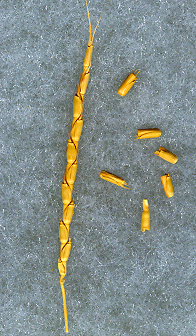Aegilops tauschii, the Tausch's goatgrass or rough-spike hard grass, is an annual grass species.[1] It is native to Crimea, the Caucasus region, western and Central Asia, Afghanistan, Pakistan, the western Himalaya, and parts of China, and has been introduced to other locales, including California.[2]
| Aegilops tauschii | |
|---|---|

| |
| Scientific classification | |
| Kingdom: | Plantae |
| Clade: | Tracheophytes |
| Clade: | Angiosperms |
| Clade: | Monocots |
| Clade: | Commelinids |
| Order: | Poales |
| Family: | Poaceae |
| Subfamily: | Pooideae |
| Genus: | Aegilops |
| Species: | A. tauschii
|
| Binomial name | |
| Aegilops tauschii | |
| Synonyms[2] | |
|
List
| |
Taxonomy edit
Aegilops tauschii is part of the tribe Triticeae, along with wheat. It is a diploid (2n=2x=14, DD) goatgrass species[3] which has contributed the D genome to common wheat.[4]
Genome edit
Zimin et al., 2016 provides a genome assembly.[5]
The Lr42 nucleotide-binding site leucine-rich repeat (NLR) is a resistance gene used in hexaploid wheat but originating in this species.[6] Lr42 confers all-stage resistance to leaf rust.[6] Lin et al., 2022 localize Lr42 to AET1Gv20040300 by cloning and sequence- and functional-analyses.[6]
Subspecies edit
The following subspecies are accepted:[2]
- Aegilops tauschii subsp. strangulata (Eig) Tzvelev – western part of range
- Aegilops tauschii subsp. tauschii
References edit
- ^ a b "Aegilops tauschii". Germplasm Resources Information Network. Agricultural Research Service, United States Department of Agriculture. Retrieved 19 January 2018.
- ^ a b c "Aegilops tauschii Coss". Plants of the World Online (POWO). Board of Trustees of the Royal Botanic Gardens, Kew. Retrieved 16 September 2021.
- ^
- Jin, Jinpu; Tian, Feng; Yang, De-Chang; Meng, Yu-Qi; Kong, Lei; Luo, Jingchu; Gao, Ge (2016). "PlantTFDB 4.0: toward a central hub for transcription factors and regulatory interactions in plants". Nucleic Acids Research. 45 (D1). Oxford University Press (OUP): D1040–D1045. doi:10.1093/nar/gkw982. ISSN 0305-1048. PMC 5210657. PMID 27924042. S2CID 3413979.
- Sims, David; Sudbery, Ian; Ilott, Nicholas; Heger, Andreas; Ponting, Chris (2014). "Sequencing depth and coverage: key considerations in genomic analyses". Nature Reviews Genetics. 15 (2). Nature Portfolio: 121–132. doi:10.1038/nrg3642. ISSN 1471-0056. PMID 24434847. S2CID 13325739.
- These reviews cite this research.
- Jia, Jizeng; Zhao, Shancen; Kong, Xiuying; Li, Yingrui; Zhao, Guangyao; He, Weiming; Appels, Rudi; Pfeifer, Matthias; Tao, Yong (2013-04-04). "Aegilops tauschii draft genome sequence reveals a gene repertoire for wheat adaptation". Nature. 496 (7443): 91–95. Bibcode:2013Natur.496...91.. doi:10.1038/nature12028. ISSN 0028-0836. PMID 23535592. S2CID 205233332.
- ^ Kishii, Masahiro (2019-05-09). "An Update of Recent Use of Aegilops Species in Wheat Breeding". Frontiers in Plant Science. 10. Frontiers Media SA: 585. doi:10.3389/fpls.2019.00585. ISSN 1664-462X. PMC 6521781. PMID 31143197.
- ^
- Kolmogorov, Mikhail; Yuan, Jeffrey; Lin, Yu; Pevzner, Pavel A. (2019). "Assembly of long, error-prone reads using repeat graphs". Nature Biotechnology. 37 (5). Nature Portfolio: 540–546. doi:10.1038/s41587-019-0072-8. PMID 30936562. S2CID 89616540.
- This review cites this research.
- Zimin, A. V.; Puiu, D.; Luo, M. C.; Zhu, T.; Koren, S.; Marçais, G.; Yorke, J. A.; Dvořák, J.; Salzberg, S. L. (2016). "Hybrid assembly of the large and highly repetitive genome of Aegilops tauschii, a progenitor of bread wheat, with the mega-reads algorithm". Genome Research. 27 (5). Cold Spring Harbor Laboratory Press: 787–792. doi:10.1101/gr.213405.116. eISSN 1549-5469. ISSN 1088-9051. PMC 5411773. PMID 28130360. S2CID 12066670.
- ^ a b c
- Huang, Jun; Liu, Sanzhen; Cook, David E. (2023). "Dynamic Genomes - Mechanisms and consequences of genomic diversity impacting plant-fungal interactions". Physiological and Molecular Plant Pathology. 125. Elsevier BV: 102006. doi:10.1016/j.pmpp.2023.102006. S2CID 257721914.
- This review cites this research.
- Lin, Guifang; Chen, Hui; Tian, Bin; Sehgal, Sunish K.; Singh, Lovepreet; Xie, Jingzhong; Rawat, Nidhi; Juliana, Philomin; Singh, Narinder; Shrestha, Sandesh; Wilson, Duane L.; Shult, Hannah; Lee, Hyeonju; Schoen, Adam William; Tiwari, Vijay K.; Singh, Ravi P.; Guttieri, Mary J.; Trick, Harold N.; Poland, Jesse; Bowden, Robert L.; Bai, Guihua; Gill, Bikram; Liu, Sanzhen (2022). "Cloning of the broadly effective wheat leaf rust resistance gene Lr42 transferred from Aegilops tauschii". Nature Communications. 13 (1): 3044. doi:10.1038/s41467-022-30784-9. PMC 9160033. PMID 35650212. S2CID 249277826.